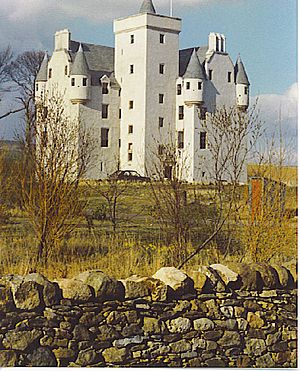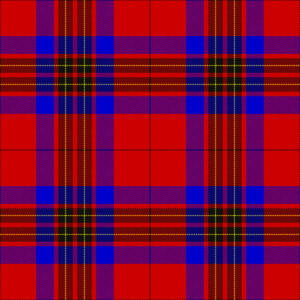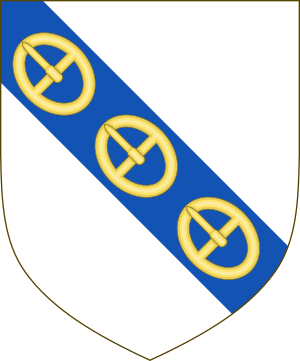Clan Leslie facts for kids
Quick facts for kids Clan Leslie |
|||
|---|---|---|---|
| Lesselyn | |||

Crest: A demi griffin Proper, armed, beaked and winged Or
|
|||
| Motto | Grip fast | ||
| Profile | |||
| Region | Lowlands | ||
| District | Aberdeenshire | ||
| Plant badge | Rue | ||
| Chief | |||
 |
|||
| Hon. Alexander Leslie | |||
| Seat | Wardhill Castle | ||
| Historic seat | Balquhain Castle | ||
|
|||
|
|||
Clan Leslie is a famous Lowland Scottish clan. The clan's story began with a nobleman named Bartolf from Hungary. He arrived in Scotland in 1067. Bartolf built a castle called Lesselyn, which is where the clan's name comes from.
Contents
Clan Chief: The Earl of Rothes
Since 1457, the leader of Clan Leslie has also been known as the Earl of Rothes. The current Chief is the Hon. Alexander Leslie. He is the brother of James Malcolm David Leslie, who is the 22nd Earl of Rothes.
Clan Leslie History
How the Clan Started
The first Leslie in Aberdeenshire was Alexander. He was made Constable of the Bass of Inverurie in 1080. He worked for the king, who was his brother-in-law.
The founder of Clan Leslie was Bartolf, a nobleman from Hungary. He came to Scotland in 1067 with Edgar the Ætheling. Edgar was the brother of Saint Margaret of Scotland, who later became queen. Bartolf married Princess Beatrix, who was King Malcolm III's sister.
People said Bartolf was very smart and brave. Because of this, King Malcolm III made him governor of Edinburgh Castle. He also gave Bartolf lands in Fife, Angus, the Mearns, and Aberdeenshire. It's said that Bartolf helped the queen cross a dangerous river on a horse. He told her to "grip fast," which became the Leslie family motto.
Bartolf settled in the Garioch area of Aberdeenshire, at a place called Lesselyn. He built a castle there. From this place, the name changed over time to Lesley and other spellings. Bartolf's son, Malcolm, became constable of Inverury Castle. His great-grandson, Sir Norman Lesley, got lands in Fife around 1282. These lands were later named Lesley.
14th to 15th Centuries: Rothes and Balquhain
The Leslie family supported Robert the Bruce against King Edward I. Because of this, they received more land in Aberdeenshire. They fought bravely at the Battle of Bannockburn in 1314. Sir Andrew de Lesly was one of the people who signed the Declaration of Arbroath in 1320. This important letter was sent to the Pope to declare Scotland's independence.
Sir Andrew's grandson, Walter, died at the Battle of Harlaw in 1411. Six of his cousins from Balquhain also died in that battle.
The main leadership of Clan Leslie later passed to a different part of the family. The current Earl of Rothes comes from this line. In 1391, Sir Norman Lesley thought his only son, David, had died in the Crusades. So, he gave his lands to his cousin, Sir George Lesley. But in 1398, David returned from the Crusades and wanted his land back. The family solved this problem peacefully. In 1445, Sir George Lesley's grandson, also named George, became a Lord of Parliament. All his lands were joined into the barony of Ballinbreich. Before 1458, he was given the important title of Earl of Rothes.
16th Century
Rothes Leslies
During the Anglo-Scottish Wars, George de Lesly was the first Earl of Rothes. His son, George Leslie, the 2nd Earl, and his grandson both died at the Battle of Flodden in 1513. The third Earl, also named George, was accused of a crime but was found innocent.
George Leslie, 4th Earl of Rothes, was one of the Scottish representatives at the wedding of Mary, Queen of Scots. This was when she was to become heir to the throne of France in 1558. George, along with three other Scottish nobles, died under strange circumstances. Many believed they were poisoned because they refused to let the crown of Scotland go to the French prince.
Balquhain Leslies
Fetternear became the home of the Leslies of Balquhain, Wardes, and Warthill. It has parts of a 14th-century palace. This palace was once home to Bishop Alexander Kininmund. He helped write the Declaration of Arbroath in 1320. This letter told Pope John XXII that the Scots would never be ruled by England. Fetternear also has older ruins, some dating back 4,000 years.
John Leslie, Bishop of Ross, was born in 1526. He was a very loyal supporter of Mary, Queen of Scots, during difficult times around 1562. John Leslie wrote the famous History of Scotland for her. He was the second baron of Wardes and received many lands from King James IV. He married five times. Today, his family line in the Garioch is represented by the Leslies of Warthill.
17th Century
During the 1600s, many Lesleys fought as soldiers for hire in Germany, France, Sweden, and the Baltic. Alexander Leslie, 1st Earl of Leven, fought in Europe. He then returned to Scotland to lead the Covenanter army. His home was Balgonie Castle, which he improved and made bigger. Alexander Leslie won a big victory against the English royalists at the Battle of Newburn in 1640.
Wars of the Three Kingdoms
Alexander Leslie, 1st Earl of Leven, and General Robert Monro led the Covenanters. They captured Edinburgh Castle with a thousand men.
In 1640, Leven and the Scots went into England. They defeated the King's soldiers at the Battle of Newburn. For this victory, King Charles I made him Earl of Leven. General Alexander Leslie of Balgonie fought for Gustavus Adolphus, the King of Sweden. He became very famous in Europe for his war skills and returned to Scotland as a Field Marshal.
In 1642, Leven went to Ireland. He commanded the Scottish Army with Robert Munro. They were sent to stop a rebellion by Irishmen who had killed Scots in Ulster. In 1644, Leven led Scottish Covenanter forces to victory over English Royalists at the Battle of Marston Moor. This was the biggest and most important battle of the English and Scottish Civil War. It meant that the King lost control of northern England for the rest of the war.
During the Civil War, General David Leslie, Lord Newark, led his Scottish Covenanter force to victory. They defeated a Scottish Royalist force at the Battle of Philiphaugh in 1645. The Royalist army was destroyed by Sir David Leslie's Covenanter army.
Dunaverty Castle was a MacDonald stronghold. During the Civil War, David Leslie of Clan Leslie led a siege against it in 1647. The MacDonalds surrendered. After they surrendered, many were killed. The castle is now a ruin, known as Blood Rock.
David Leslie also besieged the Royalist soldiers at Kincardine Castle. The Chief of Clan MacNab was holding the castle. He realized he couldn't defend it much longer. One night, he and 300 men fought their way through Leslie's soldiers. Most of them escaped, but the MacNab chief and one other man were captured. They were sent to Edinburgh as prisoners. The chief was sentenced to death, but he escaped and rejoined King Charles to keep fighting.
Leslie's Scottish Covenanter force was defeated by Scottish Parliamentarian forces at the Battle of Dunbar (1650). These forces were loyal to the Parliament of England and Oliver Cromwell. Leslie then successfully led the Scottish Royalist forces at the Battle of Carbisdale (1650). He won against Scottish Royalist forces.
Leslie's Royalist forces were defeated at the Battle of Worcester in 1651. Leslie wanted to fight in Scotland, where the King had more support. However, King Charles insisted on fighting in England. Leslie was captured and put in the Tower of London. He stayed there until 1660, when the monarchy was restored.
Balquhain Leslies
Walter Leslie (1607–1667) spent his career in Europe. During the Thirty Years War, he became very important after leading the assassination of a general in 1634. He became a field marshal and an imperial count.
Sir Alexander Leslie of Auchintool was a general in the Russian army. He was also the Governor of Smolensk. The seventh Earl of Rothes was made Duke of Rothes by Charles II in 1680.
18th Century
John Hamilton-Leslie, 9th Earl of Rothes, was the Vice Admiral of Scotland. He was also the governor of Stirling Castle. During the Jacobite rising of 1715, he supported the British government. He commanded a cavalry regiment at the Battle of Sheriffmuir. He sold much of the clan's lands. However, Leslie House near Fife remained the home of the Earls until 1926.
Clan Leslie Castles and Homes

- The Bass: This was the first Clan Leslie wooden castle, built around 1080–1085. You can still see its remains near the River Ury in Inverurie.
- Leslie Castle in Aberdeenshire: This is a 17th-century tower house. It stands where an older fort once was. The Leslies owned these lands from at least the 11th or 12th century.
- Castle Leslie in County Monaghan, Ulster, Ireland: Built in the 17th century, this castle and its large estate are still owned by the Leslie family. It is also a guest house, spa, and cooking school. In 2002, Sir Paul McCartney got married in the Family Church next to the castle.
- Fetternear Palace in Aberdeenshire: The Leslies built a tower house here in the 1560s. The castle later went to another family but returned to the Leslies. They kept a special banner there called the Fetternear Banner.
- Balquhain Castle in Aberdeenshire: The Leslies owned this castle from 1340. It was attacked and damaged during a fight with the Clan Forbes in 1526.
- Balgonie Castle: Alexander Leslie bought this castle in 1635.
- Leslie House in Fife: The Leslies owned this house until 1919. A big fire destroyed most of the house and its contents.
- Kininvie Manor House: This house is in the Spey Valley near Rothes. The Leslies have owned it since 1521 and still do. It is currently the home of Colonel David Leslie.
- Lickleyhead Castle in Auchleven, Aberdeenshire: Built around 1450, the Leslies owned this castle until 2018.
- Wardhill Castle in Meikle Wartle, Aberdeenshire: This castle passed to the Leslies in 1518. Their descendants still own it today.
- Wardhouse in Aberdeenshire: The Leslies owned this in the 16th century, but it later went to the Clan Gordon.
- Rothie House: This house was owned by a branch of the Lord Rothes family. The family line ended after the only son was killed in Italy in 1944 during World War II.



